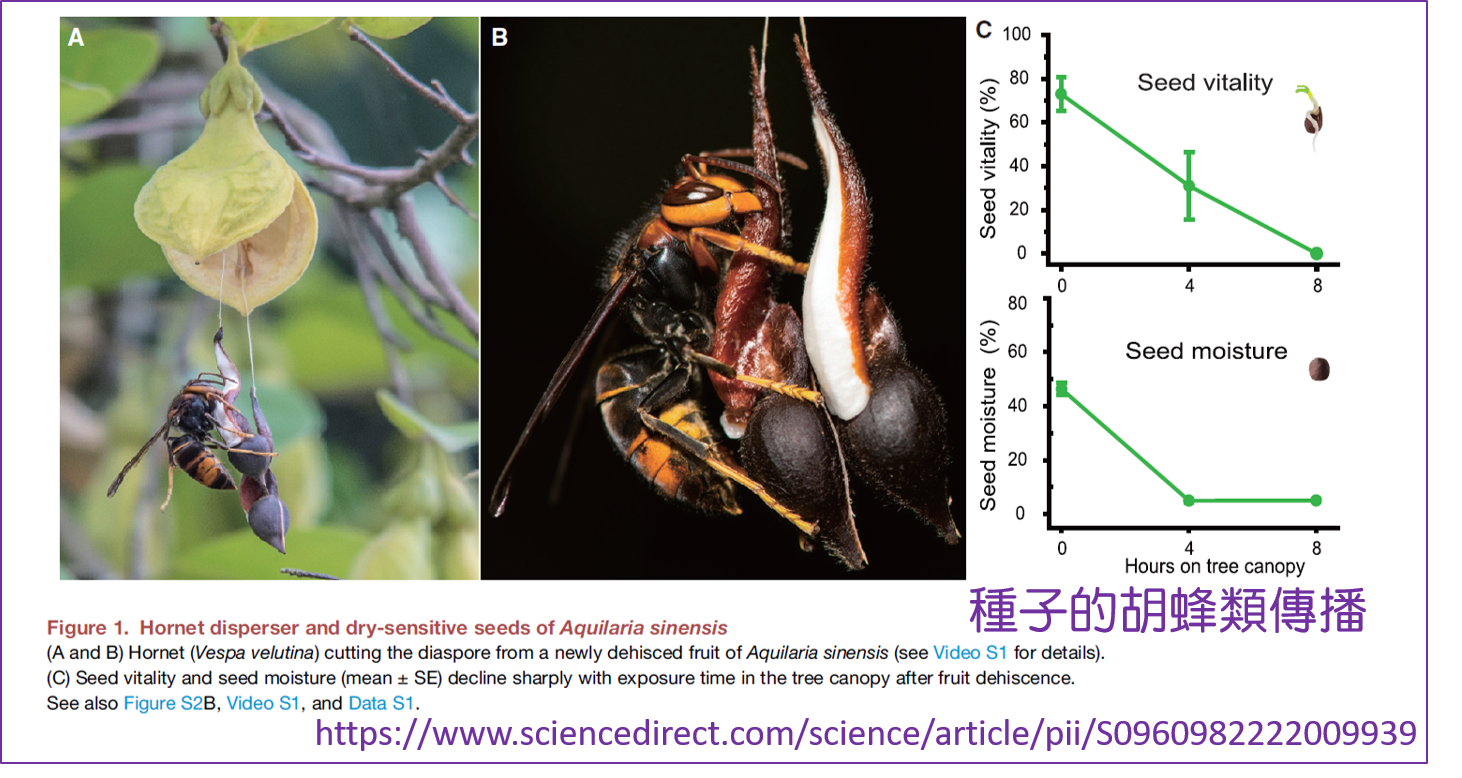西雙版納熱帶植物園學者今年八月發表論文,指出胡蜂會傳播種子。
我在《種子學》專書中提到動物傳播種子,有點到螞蟻、爬蟲、鳥、魚、哺乳、與蝙蝠等六類,卻漏掉了蜂類。可能當初主要是根據van der Pijl在1982年出版的種子散播專書來蒐集研究報告,沒能看到少數的蜂類傳播論文。
根據Lengyel et al.的調查,全球被子植物中至少有77科(所有科的17%)、334屬(2.5%)、11000種(4.5%)的種子可經由螞蟻類傳播(Myrmecochory)。與螞蟻同是非脊椎動物的蜂類,其傳播的植物種類是非常少。
最早報告蜂類可以傳播種子的是澳洲昆士蘭大學昆蟲學系的Helen M. Wallace,她在1995年發表論文,指出無刺蜂Trigona carbonaria採集毛葉桉(Corymbia torellian,異學名Eucalyptus torelliana)果實裡的樹脂來築蜂巢時,樹脂黏著種子而攜離母體,沿路散播並在蜂巢附近密集生長。
她把種子的蜜蜂類傳播命名為Mellitochory。-chory是離開,mellitus是拉丁文的甜蜜、蜂蜜。後來的學者也發現其他無刺蜂也會傳播糙葉絞麻樹(Coussapoa asperifolia subsp. magniflolia)、大合歡屬Zygia racemosa的種子。
就在蜜蜂類傳播(Mellitochory)一詞出現後,美國密西根大學生物學系的Erik S. Jules也於1996年發表論文,指出另一種蜂類,即胡蜂,Vespula vulgaris,會採食卵葉延齡草(Trillium ovatum)、小蘗科Vancouveria hexandra種子上的油粒體,而將種子帶開母體,種子掉在土上,再由螞蟻進行二次傳播。
他把此現象稱為胡蜂類傳播(Vespicochory);文中指出,這個情況早在1985年就由O. Pellmy發現過。胡蜂類傳播也發生在百部(Stemona tuberosa)。
西雙版納熱帶植物園的新論文指出有三種胡蜂可以傳播牙香樹(土沉香) Aquilaria sinensis的種子。
文章指出,牙香樹長在熱帶森林中,果實成熟時在盛夏乾燥有陽光的下午裂開,連接種子與油質體(elaiosome)的長條絲狀珠柄垂掉露出果實之外,吊在裂果之外4小時種子會乾掉,之後再4個小時種子就全部死掉,(典型的異儲型種子recalcitrant seeds)。

幸好果實一裂開,會釋放短鏈碳氫化合物,如醛、酮、醇、酸類等有氣味的小分子,幾分鐘內就吸引來胡蜂,把絲狀珠柄剪掉,帶走油質體與種子。胡蜂吃掉油質體,種子掉到陰涼潮濕處不會立刻乾燥,能夠存活較久,一個月內會長出幼苗。
所以牙香樹用香氣誘引胡蜂來取食,同時也讓牙香樹種子躲過短命的特性,而能夠發芽延續族群的生命,又是互惠共生的現象。